Womanifesto Residency Program 2008
วูแมนนิเฟสโท เรสซิเดนซี่ โปรแกรม 2551
Womanifesto Residency Program is held in a unique environment and location, where diverse visions and life efforts of the elders and a younger generation of people have come together to ensure continuity of a way of life that includes engaging various forms of art.
Based on Boonbandarn Farm in the Isan region, North-east Thailand, the Residency Program invites women artists to interact with local communities and art forms, a rural way of life, and explore the diversity and richness of the cultural ways of the community that includes Lao, Khmer, Suay, and Yao people. The focus is also on linking traditional and contemporary art and cultural practices, and to promote discussions about, and an exchange and interaction between the traditional and contemporary via creative activities. Along with engaging in individual practices, the invited artists conduct group workshops that involve students from local schools, vocational institutes and University art schools that rarely have the opportunity to interact within this form of art and culture discourse.
Aimed at generating an on-going dialogue the Residency Program is to be held for six weeks annually, with the first one realized in October/November 2008. First forged at Womanifesto Workshop 2001, further links between various generations of individuals – contemporary artists, traditional practitioners, and the community, continue to be established via this artist-led initiative.
Overview
The first residency was held from October 12 to November 15, 2008 and the following artists were invited to participate:
-
Pan Parahom
Thailand
-
On-Anong Klinsiri
Thailand
-
Naruemon Padsamran
Thailand
-
Graciela Ovejero
Argentina
-
Liliane Zumkem
Switzerland
-
Phaptawan Suwannakudt
Thailand
-
Organised by:
Nitaya Uaereeworakul and Varsha Nair
-
The 2008 artist-in-residence program is partially funded by:
The Office of Contemporary Art, Ministry of Culture, Thailand
-
Individual support received from:
- Pathanajarin Suankeawmanee
- Kabkeaw Suwannakudt
- Lena Eriksson (Artist and Curator of Lodypop in Basel, Switzerland)
- Bildwechsel (The Woman’s archive, Hamburg, Germany)
Acknowledgement
- Office of Contemporary Art, Ministry of Culture, Thailand
- Apinan Posayanont
- Nardnisa Sukchit
- Somsak Chaothadapong,
- Khunpo Boonchan Parahom
- Badarn Parahom
- Maitree Parahom
- Patchuda Sudsang
- Tiam Meesri & Esan Paya (poets)
- Nongkarn Mowlum group
- Mae Khantong Mowlum group
- Ditikarn Saanan
- Pongpan Kaeoon
- Dusadeethorn Boonreme
- Nonthavat Channam
- Marisa Parasoon
- Sookniran Thongmak
- Rungtiva Vorthong
- Prateep Suthathongthai
- Preecha Poompae,
- All participating artists
- All participating students from local schools/college/university
- Duang
- Jeep
- Pan
- Pi Nongluk
- Mae Tume
- Chian
About the organizers
Born in Udonthani, Thailand, Nitaya Ueareeworakul has a BFA from Faculty of Fine and Applied Art, Chulalongkorn University, Bangkok. Nitaya lives in Kantaralak, North-east Thailand, where she is also part of the Border Art Group that conducts community art workshops. She is one of the founding members of Womanifesto, and co organiser of Womanifesto Residency Program 2008.
Born in Kampala, Uganda, Varsha Nair has a BFA from Faculty of Fine Arts, Maharaja Sayaji Rao University, Baroda, India. Since 1997, she has also co-organized various art events and projects; the last three projects for Womanifesto: Womanifesto Workshop 2001, Procreation/Postcreation 2003 and No Man’s Land 2006, were conceptualized by her. Varsha has lived in Bangkok, Thailand, since 1995.
Artists in Residence
Pan Parahom (Mae Pan)
Notes from the farm
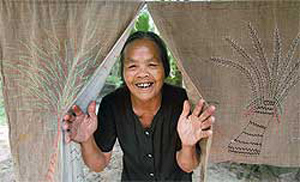
Pan Parahom (Mae Pan)
I have never experienced being part of this kind of a project. I have gained a lot from other participants and their way of thinking. I would like to make a work and add this knowledge to it – create a cloth where each participant’s presence will be in the piece.
I am proud and happy that everyone comes here from different places to participate on this land. My life changed when I came here. This land, I feel, is ancient and it was fated that I be here. We are all here too, because it is meant to be. It is because of the land; we are related to the land.
This land can educate people.
It is a place where people come from everywhere to get something. In my lifetime I thought of the land of becoming just this – for people to come, and meet and feel joy.
There is 20 rai back there that I want to keep as it is, do not want to cultivate – it’s always been like this, where also fruit trees are growing naturally in the wild. I want to preserve this. When something troubles me, or I have something to think about and resolve I walk in this place and it always helps me find a way.
I don’t think I do anything great – part of it is just to enjoy myself. Other people may not recognize or relate to what is going on. But I am enjoying something that other people cannot see.
People say that there is something mysterious here, something that cannot be explained. I have never felt scared or unsafe, or that there is any danger. And those people who come here and feel the same way, I can well understand them. I think that the ‘something mysterious’ does not mean to harm but means well to all who come and stay here. Please feel you are part of the land.
Pan Parahom, Khun Mae Pan, is 70 years old and has worked on her farm all her life. She researches and experiments with vegetation on the farm to make natural dyes for yarn, which she then weaves into cloth. She is instrumental in bringing the local community together via her practice.
Onanong Glinsiri
Togetherness & The Way We Were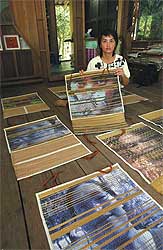
I am interested in craft & art and chose to work with woven mats as material for my work. This material is simple and has been part of daily life in Thailand for a long time. They have been used throughout our life – from birth to death. The texture is simple, with natural earth tones that come from dried reeds.
In my work State of Limbo, 2006, I cut a finished woven mat into hundreds of small pieces (10×3 inches). I then sewed them together and made a two pointed Thai roof, one side with the right side up, and the other side, upside down. They were hung from the ceiling. My wish was that I would have chance to learn how to weave this material, then I could continue working with it in my own way.
It was about a year ago now that the chance arrived in the form of an invitation to join the Womanifesto Residency Program led by Nitaya Ueareeworakul. The program aims for artists to find a way to work with art and crafts in Isarn.
At the start of the residency I asked Mae Pan, one of the participants to assist me by teaching me how to weave a mat; even though she herself had to prepare her work for the workshop as well as her own project, she agreed. She also told me stories, particularly Buddhist allegories as well as about the techniques of natural dyes made from barks of the trees and plants growing on the farm. Moreover, she consoled me and helped me get rid of the fear I felt during my early days on the farm. She said that all beings and things can live together in harmony, which helped get rid of my fear.
During the time I was on the farm I felt the human to human connections. We gradually learnt how to live, share and care for each other, like mothers to daughters, sisters to sisters. All became good friends here, even though we still needed to find our own space to create work. At first the surrounding nature determined our way and then we found a way to live together, which lead us to adjust and accept each other – human to human, human to nature.
We finally had to part with each other and go back to our own routine and activities.
At Rai Boonbandarn, I have found a culture of giving and sharing in the physical sense.
Born in 1972, On-anong Glinsiri achieved her MFA in Painting from Silpakorn University, Bangkok, in 1997. She is currently Instructor in Painting at Bundit Pattanasin Institute’s Fine Art Department, Bangkok. Her experience includes organising various workshops and events. On-anong exhibited at Womanifesto II in 1999. Her recent shows include “No Wall: Art and Friendship” (2008); The 8th Thai Contemporary Art Exhibition 2007, Silpakorn University; Hers group 03, Hof Art, Bangkok (2007).
Naruemon Padsamran
Kor Kwaay Dong Khao Na…Kor Khon Dong Khueng Khang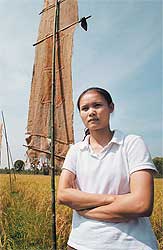
When society changed some farmers sold their land in order to send their children to school. This is also for their children to become big bosses. The question is – if this is farmers’ expectation for their children, then who will be the hope for the children. If the farmers do not grow rice whose rice will the children of farmers eat?
Born in 1981 in Roi Et, Thailand, Naruemon Padsamran gained her BFA from Mahasarakham University in 2006. Coming from a farming background she was also brought up with Mowlum, the music tradition of Isarn, Naruemon’s work is inspired by the figures, rhythm, sound and colour of this popular performance genre that involves several singers, a dance troupe, comedians and traditional instruments. She exhibited at “Brand New” 2007, at Bangkok University Gallery.
Graciela Ovejero
A Spirit House for Located Memory- Post-cards from Tucumán and Isarn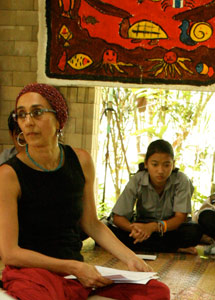
The conceptual core of this project is an open investigation of memories, local knowledge and the flux of identity as related to place, in the context of piercing globalization and generational gaps. This investigation first took place in 1997, in Tucumán Argentina, my place of origin, through an invitation for local artists to produce and object/souvenir reflecting their memory and ideas about Tucumán. In this way the Nomadic Anthology of Objects was formed. I have traveled with those objects (91) or images of them, carrying the same questions presented to the artists of Tucumán in the context of workshops and conversations, creating different installations in dialogue with local materials and themes, sometimes including contributions of artists and other people in the places of arrival.
In this case, a workshop with a group of art students and contributions by friends have provided some snap shots to pair printed images of the souvenirs from Tucumán, along with my own register of the visit and experience in this region of Thailand. The images, displayed on banana leaves, were hanging from the ceiling of a bamboo hut structure built in the garden of the Residency compound, in observation of traditional architecture and shapes that are being gradually replaced by more standard concrete forms. The hut, crossed with the skeleton of a large boat, also built with bamboo, is conceived both as a sacred space to house the postcards and as a sculpture. Hut and boat conform an outlined spatial system integrating female and male symbols, groundedness and mobility as aspects of culture and individual identities, placed in the direction East-West. The postcards hanging inside were visible from all angles of the open structure and translucent fishnet roof, yet inaccessible for scrutiny, as in the case of relics –also a present tradition in the context of Theravada national form of Buddhism–, configuring a sort of mobile that resembles the display of goods in many of the local craft shops.
Spirit Houses, are a visible presence in the gardens and house fronts throughout Thailand, a bit as in the random case of plaster goblins and flamingos in the west, but with a lot more symbolic gravitation and reverence. They are table top size and larger replications of temples, at times clearly demonstrating the level of wealth of the household, placed on a column that elevates them at eye level. Dedicated to the spirits of nature, their purpose is to protect the house and its inhabitants. They tend to be very colourful and are regularly cleaned up and ornamented with flowers as remainings of timeless animism.
Not knowing before hand what final format would result from the interaction with the community and students and dialogical aspects of my work, I was deeply inspired by the daily effort of human doings in the midst of a natural setting of powerful dynamics and abundant materiality, which demands constant work. I decided to build a distinct sacred space to dialog and contrast nature, noticing later on that the farm, exceptionally, did not actually have a spirit house
The installation as a complete work lasted just one full moon night and the next sunny day of open studios sharing event with community artists, journalists and various groups of students and children from near by villages. This took place on the 13th and 14th of November, in the context of celebrating the conclusion of the 5 weeks residency and the art projects conceived during it.
I have dedicated the piece to the whole family of Boonbandarn Farm where the Womanifesto Residency took place, a family of artists farmers, and particularly to Khun Mae (Pan Parahom) and Khun Pou (Boonjan Parahom), the elders who’s life efforts and personal visions have made the place come to existence. On the afternoon of the last day of residency, open to public, all the images hanging inside the memory-boathouse were given to the visitors as souvenirs, leaving the space vacant for new memories and functions. Graciela Ovejero. Boonbandarn Farm, November 2008.
Especial thanks to: all members of Boonbandarn family for their generosity sharing their home and knowledge, Womanifesto organizers for their diligent work, commitment and vision, to participating artists for their attentive companionship, to both workshop participating students and their enthusiastic teachers, Phaptawan Suwannakudt for near constant interpretations and translations between Thai and English, to Pi Nong Lak, Chian, Mae Tume, Jeep, Duang, Pan, Run and On-anog Glinsiri, for their help and assistance at various moments of the work process.
Born in I San Miguel de Tucumán, Argentina, Graciela Ovejero obtained a Master in Fine Arts from the University of California in San Diego, a Licenciatura en Artes Plásticas from National University of Tucumán/U.N.T. and a Professorship in Classical Dance. Graciela has participated in various group exhibitions since 1976, produced 29 individual shows and installations in museums and galleries of Argentina, Mexico, USA, Japan, Spain and Pakistan. She works and lives in and between California and the North-west of Argentina.
Liliane Zumkemi
The Peace Audition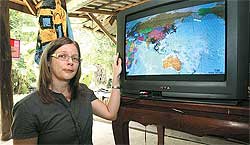
During my stay I felt becoming human again and forgetting about the artificial pace of our big city lives.
Breathing, Talking, Eating, and Sightseeing.
Listing to the army helicopters circling around the temple complex of Preah Vihear and the TV broadcast by the PAD many hours a day, the artwork developed itself.
“The Peace Audition”, a video depicting snails with the peace symbol on their shells start their move in Thailand. The soundtrack “Khon klai barn 1 by Caravan” was chosen with the helpful advice of the habitants of the first Womanifesto Residency.
Liliane Zumkemi was born in 1971 in Ried-Brig in the Swiss alps. From 1992 to 1998 she studied Art at Ecole Cantonale des Beaux Arts in Sion and Lucerne University of Applied Siences and Arts. In 1998 she completed her Master degree and won an award from the state of Valais. She often uses video, performance and installation as media to visualize her concepts. Since 1998 she has exhibited her works in over thirty exhibitions in Europe, USA and Asia. Liliane has been living in Bangkok, Thailand since 2000.
Phaptawan Suwannakudt
Casting off a Memory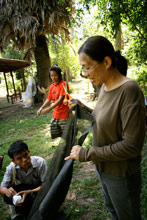
Casting off a Memory also contains experiences shared by artists and all the beings and things in the farm. The activities we did collectively or on own has created a kind of interconnectedness that is woven together by the moments we shared during the time of the residency.
Rai Boonbandarn Farm, November 2008
I would like to thank:
- Organisations and individuals who sponsored by funding the project
Nitaya Ueareeworakul, Varsha Nair, the artists who co-organised the program - Participating artists with whom I learned new things
- Khun Por Boonchan and Khun Mae Pan Parahom, Khun Badarn, Khun Maitree and all members of Rai Boonbandarn Farm
- Artists from Border Art Group who assisted in the program
- Teachers and students from schools, colleges and universities who participated in the workshop
- Roong, Pan, Jib and Krue Duang who assisted with the workshop and installation
- All the beings and things in the Farm
- John, Chanchaaysaeng and Yenlamtarn for their support, time and patience
- Organisations and individuals who sponsored by funding the project
After graduating from Silpakorn University, Thailand, with a degree in English and German, Phaptawan Suwannakudt completed her MVA degree at Sydney College of the Arts, The University of Sydney. From 1980 to 1990, she worked extensively on several full-scale temple schemes and hotel decoration projects in Thailand. She has exhibited solo in Sydney, Bangkok and Melbourne and participated in many group exhibitions. Phaptawan was one of the cofounders of Womanifesto in 1995, before she migrated to Australia. She lives and works in Sydney.
